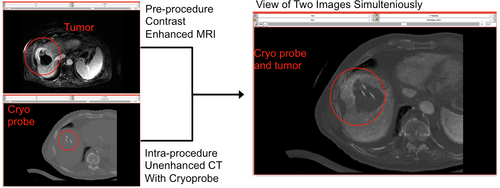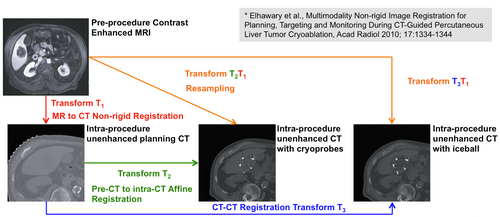Difference between revisions of "Non-rigid MR-CT Image Registration"
| Line 10: | Line 10: | ||
The case study is liver tumor cryoablation. | The case study is liver tumor cryoablation. | ||
In this tutorial, the three steps are performed as shown the figure on right side. | In this tutorial, the three steps are performed as shown the figure on right side. | ||
| + | (1) In MR-planning CT image registration, we can obtain the deformed MR image and the Bspline transformation matrix T1 by using pre-procedure contrast enhanced MRI. | ||
| + | (2) In plannning CT-intraprocedure CT image registration, we can obtain the deformed planning CT image and the Bspline transformation matrix T2. | ||
| + | (3) In MR-intraprocedure CT image registration, we can obtain the deformed MR image by using T1 and T2 BSpline transformation matrices. | ||
| + | |||
==Tutorials== | ==Tutorials== | ||
Revision as of 22:38, 3 June 2011
Home < Non-rigid MR-CT Image Registration

Contents
Non-rigid MR-CT Image Registration Tutorial
Overview
This tutorial demonstrates how to perform MR-CT and Ct-CT non-rigid image registrations. The case study is liver tumor cryoablation. In this tutorial, the three steps are performed as shown the figure on right side. (1) In MR-planning CT image registration, we can obtain the deformed MR image and the Bspline transformation matrix T1 by using pre-procedure contrast enhanced MRI. (2) In plannning CT-intraprocedure CT image registration, we can obtain the deformed planning CT image and the Bspline transformation matrix T2. (3) In MR-intraprocedure CT image registration, we can obtain the deformed MR image by using T1 and T2 BSpline transformation matrices.
Tutorials
Non-rigid MR-CT Image Registration Module tutorial : to perform MR-CT and CT-CT image registration [ppt] [pdf]
Tutorial materials
ShapeAnalysisModule data :
- Link to NITRC
- or directly here : ShapeAnalysisModuleTutorialData_TutorialContestSummer2011.zip
People
Atsushi Yamada, Ph.D. (Research Associate, Brigham and Women's Hospital and Harvard Medical School)
Dominik S. Meier, Ph.D. (Assistant Professor, Brigham and Women's Hospital and Harvard Medical School)
Nobuhiko Hata, Ph.D. (Associate Professor, Brigham and Women's Hospital and Harvard Medical School)